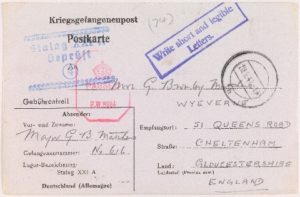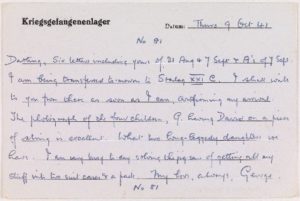By Clare Makepeace
There is no historical source I enjoy reading more than personal correspondence. It is so deliciously intimate, being a private communication between two individuals. It must also must satisfy a slightly wicked streak in me because I take a certain amount of pleasure in reading something I know was never intended for my eyes. In some ways, it also makes for a nice, straightforward source to analyse. You know exactly who the letters were written to, so it is easier to work out how the audience affects the source’s contents.
Letters have been one of the foundations of my research into the experiences of servicemen who fought in the two world wars. My recent monograph, Captives of War, explores the experiences of seventy-five British POWs held in Europe during the Second World War. As well as diaries and scrapbooks, it draws upon twenty-six collections of correspondence composed during captivity. POWs were entitled to send home at least two letters and four postcards a month, relatives could write letters no longer than two sides of notepaper once or twice a week.

Some of these collections are lengthy. The most extensive was between Greaser Claude Bloss and his wife Dorrie. They married just nine weeks before the war split them apart. Dorrie was already expecting their first child when Claude was captured on 8 May 1940. Over the next five years, he wrote her 94 postcards and 129 letters from his POW camps in Germany; she sent him a staggering 558 letters. Their correspondence is a heartrending and mesmerising read, of a newly-wedded couple grappling with issues of trust and jealousy, of a father who had never met his daughter and of a man negotiating five long, uneventful years behind barbed wire.
That last point interested me most and was why I drew upon letters so extensively in my research. For me, the crucial and valuable characteristic of letters is that they are written at the time of captivity. I make quite a big deal in my book about the importance of distinguishing between sources written during wartime incarceration and those written retrospectively. When I read memoirs written by ex-POWs alongside diaries and letters, I was shocked by how different not only their content was, but also their tone. The letters and diaries were full of tenderness, rawness and humility because, and this point is crucial, they were written while these men were vulnerable to their conditions, unaware of whether they would survive them. With survival, I think, comes confidence, sometimes even bravado. This infiltrated numerous memoirs; they felt contrived.
Any such manipulation is ultimately a strength. It tells us how memories alter and evolve in dialogue with the wider cultural context, but that was not what interested me. I wanted to understand how it felt to be in captivity, how POWs psychologically responded to it and how they made sense of spending a war behind barbed wire.
Correspondence told me much about this. Being written at a series of moments, over a period of time, letters chart how the experience of captivity unfolded. One of the hallmarks of wartime imprisonment is the indeterminate sentence. The received wisdom by historians, and an understanding that dominates memoirs, is that one of the greatest hardships borne by captured servicemen was that their incarceration would last for years to come. The letters, backed up by entries in private diaries, tell us something entirely different. ‘I’m hoping to be home for Xmas’ wrote an optimistic Sergeant Brett to his parents on 30 August 1940, ‘and have even ordered a turkey from a fellow here who works at Smithfield Market’ he added.
Letters also record the fantasy lives lived by POWs; lives that are almost entirely absent from memoirs. When individuals live a monotonous, empty existence, they fill it with thoughts, feelings or fantasies that retrospectively would be impossible and, having served their purpose, probably also irrelevant, to recall. One fantasy that POWs lived out was the synchronisation of their thoughts with those of their loved ones, achieved through the medium of letters. Lieutenant John Evans was a 33-year-old father of two who had joined the Royal Navy in 1928. Despite having been away from home regularly, when in captivity he sought support from his wife through synchronisation. He wrote to her in February 1943: ‘Think of me at 08.30, 12.30, 16.00 and 19.00 hrs. They are the most disappointing moments for me.’ He did not reveal to his wife why these times were so trying. I assume they were his meal times. The younger and only recently married Sergeant Ernest Ball presumably had less melancholic thoughts in mind when he sent his wife similar instructions. He advised her that his bedtime was 11 p.m., ‘that will be ten in England so I hope you are in bed by then’.
 The overwhelming importance of letters to prisoners of war, and a virtue I had not fully anticipated when I started my research, was their symbolic power. The receipt of letters was so important that it helped POWs to overcome their wretched conditions. As Sergeant Major Andrew Hawarden described it, on 14 December 1940, ‘Somehow coffee seems a little better, you get up that little brighter, your soup is not too bad after all, you go about your job with a little lighter step and somehow your boots are not quite so heavy’. This symbolic potency comes to the fore when POWs used metaphors of food to describe the arrival of mail in the camps: a highly significant choice for men whose lives were dominated by hunger. Captain John Mansel described it as a feeding frenzy. When he wrote to his mother on 27 October 1940, he encouraged here to ‘Visualise feeding time at the Zoo and you have a fair picture of the scene here when the letters arrive – visualise also the poor animals that weren’t thrusting enough & you can complete the scene with those, greedily eager a moment before, walking away despondent. Today I had a good meal – two from you . . . one from George Banks, one from Tim’.
The overwhelming importance of letters to prisoners of war, and a virtue I had not fully anticipated when I started my research, was their symbolic power. The receipt of letters was so important that it helped POWs to overcome their wretched conditions. As Sergeant Major Andrew Hawarden described it, on 14 December 1940, ‘Somehow coffee seems a little better, you get up that little brighter, your soup is not too bad after all, you go about your job with a little lighter step and somehow your boots are not quite so heavy’. This symbolic potency comes to the fore when POWs used metaphors of food to describe the arrival of mail in the camps: a highly significant choice for men whose lives were dominated by hunger. Captain John Mansel described it as a feeding frenzy. When he wrote to his mother on 27 October 1940, he encouraged here to ‘Visualise feeding time at the Zoo and you have a fair picture of the scene here when the letters arrive – visualise also the poor animals that weren’t thrusting enough & you can complete the scene with those, greedily eager a moment before, walking away despondent. Today I had a good meal – two from you . . . one from George Banks, one from Tim’.
Letters were a means by which prisoners of war conveyed their experiences in captivity. More importantly, they were lifeblood for these men. Given my penchant for prying, I’m delighted the same can be said for so many histories.

Dr Clare Makepeace is the author of Captives of War. British Prisoners of War in Europe in the Second World War (Cambridge University Press, 2017) and an Honorary Research Fellow at Birkbeck, University of London. Her article on Living beyond the barbed wire: the familial ties of British prisoners of war held in Europe during the Second World War is included in the latest free virtual issue of Historical Research, which draws together past and present Historical Research articles and IHR podcasts on the theme of Correspondence.
Images show the standard letter-form and postcard that POWs were permitted to send from captivity. Reproduced with permission from Gillian Stein.

